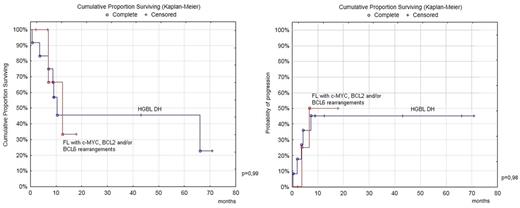Abstract
Introduction. An appearance of secondary c-MYC gene rearrangement in patients with follicular lymphoma (FL) can predispose to histologic transformation of FL and aggressive clinical course of disease. Approaches to follicular lymphoma with с -MYC, BCL2 and/or BCL6 rearrangements treatment are not clearly defined.
Aim. To compare clinical characteristics and treatment efficacy in groups of patients with FL histologic transformation or blastoid variant of FL with c-MYC, BCL2 and/or BCL6 genes rearrangements and HGBL double-hit (DH).
Patients and methods. We analyzed data (since 2004 to 2017 years) from a single-center observation of 12 pts with high grade B-cell lymphoma (HGBL) DH, and 5 FL pts with c-MYC, BCL2 and/or BCL6 rearrangements (2 with histologic transformation into DLBCL, 2 cases of FL grade 3A with blastoid morphology and 1 FL grade 3B). Median follow-up was 9,3 (from 0,6 to 71,1) months. These groups did not have significant differences in clinical parameters such as age, ratio between men and women. In both groups majority of patients had ECOG≥2, III-IV stage of disease according to Ann-Arbor classification, high frequency of extranodal involvement (over 80%), bone marrow involvement (40-55%), high activity of LDH. In pts with HGBL DH Ki-67 expression level was significantly higher (median 93% (from 80 to 100%)) than in FL pts (median 70% (from 35% to 80%)), p=0,0037. Three pts with HGBL DH underwent CHOP-21±R, 2 pts - R-(DA)-EPOCH with lenalidomide maintenance, 7 pts - BL-M-04+R. 4 pts with HGBL DH achieved complete remission (CR) (2 - after BL-M-04+R, 1 - after R-DA-EPOCH, 1 - after CHOP), 2 pts achieved partial remission (PR) (1 after R-EPOCH), 7 pts had progressive disease (PD) (6 - after BL-M-04+R, 1 - after R-CHOP). 4 patients underwent autologous stem cell transplantation (autosSCT) 2 - in CR, 2 - in PR. Two pts transplanted in PR had PD 1-3 months later. Three pts with anamnesis or current diagnosis of FL underwent R-(DA)-EPOCH (1 with transformed FL, 2 - with blastoid variant of FL), 2 - R-CHOP-21 (1 pt with transformed FL, 1 pt - with 3B FL). From 3 pts after R-DA-EPOCH - 1 pt with blastoid variant of FL had CR (Ki-67 was 40%), 1 pt with blastoid variant of FL had stable disease (SD) (Ki-67 was 70%), she achieved CR after 3 R-DHAP, autoSCT now is planning. 1 pt with transformed FL had PR after R-DA-EPOCH and after 2 R-DHAP had PD (Ki-67 was 80%), subsequently died at 12,4 months. One pt is alive taking R-CHOP-21 (FL3B), one pts died due to PD after 6 R-CHOP-21 (with transformed FL, Ki-67 was 80%). Median overall survival in pts with HGBL, DH, was 9,6 (0,6-71,1) months; in pts with diagnosis or history of FL - 7,0 (2,4-19) months, p=0,99. Median time to progression (TTP) was 5,8 (0,3-71,1) months in first group and 7,0 (2,4-19) months in second group, respectively (p=0,98).
Conclusion. Pts with de novo HGBL DH have a similarly poor prognosis as pts with histologic transformation of FL with c-MYC, BCL2 and/or BCL6 rearrangements. Cases corresponding to morphological criteria of FL with c-MYC and BCL2 rearrangements can differ in clinical course from indolent to highly aggressive depending on proliferative potential of tumor cells. Majority of FL cases with c-MYC and BCL2 rearrangements are characterized by aggressive clinical behavior and require more intensive approach than R-CHOP-21. We suggest that FL pts with c-MYC, BCL2 and/or BCL6 rearrangements could have benefit from R-(DA)-EPOCH. It is reasonable to consider FL pts with c-MYC, BCL2 and/or BCL6 rearrangements as candidates for consequent high dose therapy following autosSCT, if partial remission or stable disease is achieved on the first line of treatment.
No relevant conflicts of interest to declare.
Author notes
Asterisk with author names denotes non-ASH members.


This feature is available to Subscribers Only
Sign In or Create an Account Close Modal